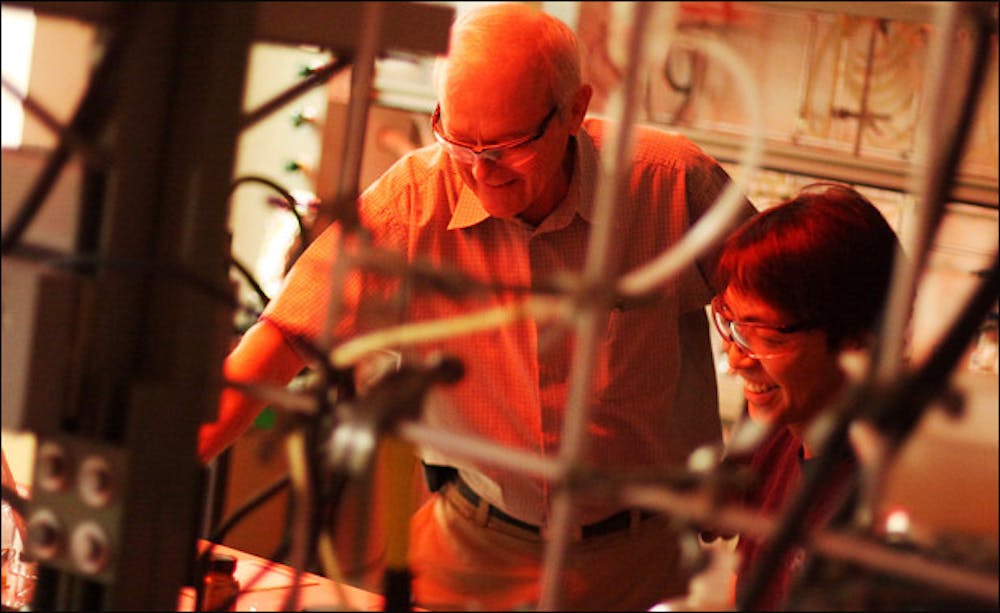ASU research groups have received more than $70 million in stimulus money since the federal stimulus was passed, an ASU official said.
Faculty and colleges at the University have been awarded 68 grants funded by the American Recovery and Reinvestment Act, said Sethuraman Panchanathan, deputy vice president for research and economic affairs.
“As soon as the grants were announced and the research funding agencies started to get these monies allocated for research projects, we were able to put together a number of proposals,” he said.
More than 300 proposals asking for more than $400 million have been submitted by ASU, he said.
The research and economics affairs department created a “war room” where employees look at all opportunities for research funding available and apply to receive the aid.
“We have a number of these proposals still being reviewed,” Panchanathan said.
Stimulus money will keep coming in at least for the next year or year and a half, he said.
Of all ASU departments and research groups, the College of Teacher Education and Leadership has received the most stimulus money so far after being granted nearly $34 million, said Scott Ridley, assistant dean of the college at the Downtown campus.
Ridley said the college will use the money to revise its program to focus on producing higher quality teachers and consider creating a four-year master’s degree program in an effort to be among the nation’s elite schools in preparing teachers.
“You don’t just get a grant like this without having some kind of track record,” Ridley said. “We have pretty good quality teacher preparation at ASU, but we really want to be excellent, and the grant really pushes us to do that.”
Ridley said the school will work with 25 other schools around the state because the Obama administration and the Department of Education want universities to partner with school districts to improve the quality of teachers and the teaching itself.
“They’re offering incentives to try to get colleges of education to work with districts that have historically not had the best teachers,” he said. “They want to ensure that all kids get a good quality teacher.”
Devens Gust, a professor of chemistry and biochemistry at the College of Liberal Arts and Sciences, was awarded $14 million over five years with his research team from the Department of Energy to fund research to figure out how to use sunlight to create hydrogen-based fuels to replace fossil fuels.
Gust and several of his colleagues have been doing research on using sunlight for fuel since the early ’80s.
“If you look around for other sources that could do the job, there’s really only one that has the capacity to make enough energy for all humans, and that’s sunlight,” he said. “We can take the basic science that underlies photosynthesis and then see if we can use that basic science to design a system that will make fuels efficient for humans.”
The grant will allow Gust’s research team to expand and make faster progress, he said.
“We’re all now trying to find out exactly what each of our subgroups are doing and how it all fits together into the overall project,” Gust said. “We’re also busy now, of course, hiring some students and researchers and so forth to help us do the work to get the project up to full speed.”
After obtaining a grant worth more than $130,000 from the National Institutes of Health, Shelley Gray, a professor of speech and hearing science, and her research group will add three experiments to another study of five experiments.
The experiments, which started four years ago, are intended to find solutions that could help children with language impairments learn more quickly.
Gray said after doing the first two experiments with her original grant money, additional questions came up that she would not have time or money to answer without the stimulus.
“What this money allowed us to do was go ahead and do the experiments that’ll answer these new questions,” she said.
Applying for stimulus money took a lot of fast work and extra effort from the faculty at ASU, she said.
“It really shows the resourcefulness and the dedication of [ASU faculty] who were able to get those applications in on time,” Gray said. “It also shows that there is a lot more important research that could be done, but there’s no funding for it.”




